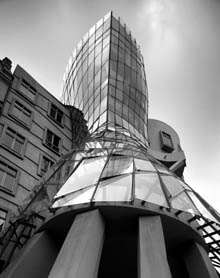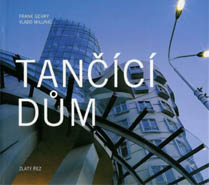
The Dancing House has become one of the symbols of Prague in ten years
 |
Ten years, which will have passed on June 20 since the official start of the trial operation of the Dancing House, as the new building was soon renamed, have proven the supporters of the project to be correct. The house has received numerous awards, is a sought-after tourist attraction, and its photo is featured in guides and publications about architecture.
In the places where the Dancing House was built between 1993 and 1996, there stood a building that was destroyed during an American air raid on February 14, 1945. The decision to develop the gap was made as early as 1963, but a significant step was only taken in 1992 when the Dutch insurance company Nationale Nederlanden purchased the land. The project chosen for realization was by Czech architect of Croatian descent Vlado Milunić, who enlisted the help of renowned Canadian-American architect and designer Frank O. Gehry.
The idea to develop the parcel was revived in the early 1990s by Milunić together with President Václav Havel, who lived in the neighboring building. The original idea involved creating a house with a library, theater, and café that would continue the cultural line from the Rudolfinum through the National Theater to the Mánes. However, it was not possible to find an investor for this non-commercial project. Nationale Nederlanden set as conditions the commercial use of the building and the participation of one of the leading world architects.
Milunić initially considered the French architect Jean Nouvel (later, according to his project, the Golden Angel in Prague's Smíchov was created), but he was successful only with Frank Gehry. As Milunić noted later, the hockey fan Gehry said at the time that he would do anything for the country that gave America Jaromír Jágr. Gehry is now mainly known for the construction of the Guggenheim Museum in Bilbao, Spain, which was completed only a year after the Dancing House. Allegedly, it was at the Prague project that Gehry tested the possibilities of using 3D computer modeling, which he then successfully utilized in Bilbao and other projects.
The cornerstone of the Nationale Nederlanden Building, as the building is officially named, was laid on September 3, 1994. The construction is based on a reinforced concrete slab supported by a system of drilled piles. Attached to the reinforced concrete structure are 99 original facade panels. The unofficial name was given to the building by two towers resembling the figures of dancers Ginger Rogers and Fred Astaire. At the top of the tower symbolizing the male figure is a dome with a tube structure covered with stainless steel mesh - the head of a jellyfish.
The building has nine floors with a vertical division into two parts. Due to the shape of the building, each floor is different. This also causes some impracticality – asymmetric rooms are difficult to furnish, and sloping walls can feel oppressive. The building also protrudes from the street line, thus obstructing pedestrians.
The building has a usable area of 2965 square meters of office space on six floors, a restaurant with an area of 679 square meters on the top floor, and a conference center (400 square meters) on the ground floor and basement. A part of the interior was designed by the renowned architect Eva Jiřičná.
The Dancing House received the highest award in the design category in the prestigious survey by the American magazine Time in 1997. In a domestic survey by the magazine Architekt, it made it among the five most significant Czech buildings of the 1990s. The Czech National Bank selected it as an example of a contemporary building for one of the ten coins it issued as part of the Ten Centuries of Architecture series.
 |
DANCING HOUSE / Frank Gehry, Vlado Milunić
at a special price 550 CZK> order here
The English translation is powered by AI tool. Switch to Czech to view the original text source.
0 comments
add comment










